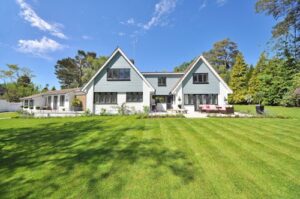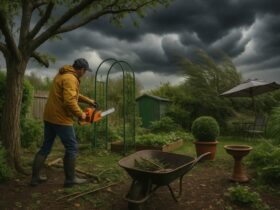Key Takeaways
- Sustainable landscaping helps conserve natural resources, nurtures healthy ecosystems, and can reduce homeowners’ ongoing yard maintenance costs.
- Incorporating native plants, efficient irrigation methods, and organic materials builds a more resilient and eco-friendly outdoor environment.
- Water-wise strategies and drought-tolerant designs protect against changing climate conditions while supporting healthier gardens.
- Valuable educational resources, such as government and expert guides, are readily available for anyone seeking to adopt greener yard solutions.
- Integrating features such as pollinator habitats, composting, and rain gardens provides both environmental and personal benefits for families and communities.
What Is Sustainable Landscaping?
Sustainable landscaping extends far beyond arranging flowers or mowing the lawn—it’s a thoughtful approach to designing, planting, and maintaining outdoor spaces that work in harmony with nature rather than against it. At its core, this strategy promotes the efficient use of resources, protects biodiversity, and makes outdoor living areas easier to maintain over time. Unlike traditional landscaping, which often relies heavily on imported plants, excessive irrigation, and frequent chemical treatments, sustainable methods aim for a balanced relationship between people and the environment.

Modern homeowners are discovering that this approach isn’t just beneficial for the planet—it’s often accompanied by thoughtful planning and budget-friendly solutions. Many now choose to enlist the affordable landscaping services that specialize in eco-friendly yard design. These professionals can help select plants that thrive in local conditions, plan efficient irrigation systems, and introduce practices that require less maintenance and input year after year. Shifting to sustainable landscaping means embracing diversity, reducing waste, and creating outdoor spaces that are both aesthetically pleasing and functional while also being resilient in the face of environmental challenges.
Why Choose Sustainable Landscaping?
There are substantial benefits to adopting sustainable landscaping at home, many of which directly impact your local surroundings and your wallet. For the environment, sustainable yard care means consuming less precious water, which is especially important as many regions experience recurring droughts and water restrictions. By prioritizing native plants and healthy soil practices, these landscapes act as mini-ecosystems, supporting wildlife such as birds, bees, and butterflies, which are often threatened by urbanization and habitat loss.
Homeowners also enjoy economic advantages: increased property value, lower water and fertilizer bills, and reduced need for harsh chemicals or lawn treatments. Diverse plantings rooted in local species are more resilient in challenging conditions and require significantly less upkeep. This means that investing in innovative, green solutions now leads to years of savings and less time spent on yard chores. With national interest in sustainability and eco-conscious trends on the rise, landscapes that work in harmony with nature can also make your home stand out in a positive light.
Key Elements of Sustainable Yard Design
A good, sustainable yard begins with the right plant choice. Selecting native or climate-appropriate plants creates a landscape that naturally complements the rainfall, temperature, and soil conditions of your region. These species are selected to thrive without excess demands for watering, fertilizing, or protection from pests. For example, once native perennials and grasses have established their roots, they can tolerate weather swings and help prevent erosion.
Water management is crucial as well. Efficient systems, such as drip irrigation or smart irrigation controllers, which adjust watering based on weather and soil conditions, ensure that every drop serves a purpose. Mulch is another cornerstone—organic materials, such as wood chips or shredded leaves, placed on soil surfaces help lock in moisture, reduce weed growth, and create a more stable environment for roots and soil life. Well-placed trees and shrubs can serve as natural shade, reducing your energy bill during hot summer months, while hedges or windbreaks can shelter both your garden and home from harsh winds, making your outdoor living space more comfortable and protected.
Water-Wise Strategies for Lawns and Gardens
With water scarcity becoming a significant issue in many communities, homeowners must seek out methods that reduce their water usage. Rainwater harvesting—collecting runoff from roofs in barrels or cisterns—provides a renewable resource for irrigating lawns and gardens, even through dry spells. Reducing the overall turf grass area is another smart step: Replacing a thirsty lawn with low-water groundcovers like clover, creeping thyme, or sedum creates a lively, green space without demanding constant watering.
Rain gardens and bioswales are gaining popularity in both private yards and public projects. These features are not only attractive but also capture and filter rainwater, naturally replenishing groundwater and preventing stormwater pollution. Many North American cities now provide incentives for residents to install these features, highlighting their value in sustainable water management. Homeowners from California to the Midwest are seeing impressive results—lower water bills, less runoff, and vibrant outdoor spaces that stay lush even during droughts.
Organic Maintenance Practices
Avoiding synthetic fertilizers, pesticides, and herbicides is key to maintaining a healthy, sustainable yard. Instead, composting kitchen waste and yard debris turns what would be trash into rich “black gold” for garden beds and lawn areas. This organic matter improves soil structure, retains moisture, and delivers slow-release nutrients to plants—all without harming wildlife or polluting local waterways.
Integrated pest management (IPM) considers the entire outdoor environment and supports beneficial insects, such as ladybugs and lacewings, that help keep pests in check. In the long term, building a pollinator garden filled with wildflowers and sheltering areas encourages birds, butterflies, and bees to visit your yard regularly. These allies promote healthy growth and naturally moderate unwanted insect populations, resulting in fewer interventions for you and a healthier ecosystem overall.
Creating Wildlife-Friendly Habitats
Sustainable landscapes provide vital habitats for birds, pollinators, and other local wildlife. Planting swathes of wildflowers, native shrubs, and fruit-bearing trees not only ensures year-round interest and color but also supplies food and shelter for many important species. Features like shallow birdbaths, bee hotels made from hollow stems, or undisturbed patches of grass and leaf litter further enhance your backyard ecosystem.
Some homeowners fear that supporting wildlife means a messy or wild look, but thoughtful design can deliver both curb appeal and biodiversity. Grouping plants in intentional, defined beds, using attractive pathways, and mixing heights and textures allows for a tidy yet lively landscape. For a detailed breakdown of which plants provide the most benefit and how to strike the right balance between beauty and functionality, the EPA shares a convenient guide to native plants tailored for homeowners, schools, and municipalities alike.
DIY Sustainable Landscaping: Tips for Homeowners
Beginning your sustainable yard journey doesn’t have to be expensive or overwhelming. Even a few changes can make a big difference—try swapping out sections of grass for native shrubs or wildflowers, layering mulch around tree bases, or installing a simple rain barrel system to catch and reuse stormwater. Many communities offer free or low-cost soil tests, compost bins, or advice through local cooperative extensions to set you up for success.
- Start composting at home to recycle kitchen scraps and boost garden fertility.
- Prioritize locally adapted plants that genuinely thrive in your specific climate and soil conditions.
- Invest in basic drip irrigation kits—they’re surprisingly easy to assemble and deliver impressive water savings.
- Arrange plantings according to their water needs to streamline your watering routine and enhance plant health across the board.
Most sustainable improvements require little more than attention, creativity, and a willingness to experiment. The satisfaction comes not only from a beautiful, functional yard, but also from knowing that your efforts contribute to a healthier environment that extends well beyond your property line.
Long-Term Benefits and Modern Trends
Over time, sustainable landscaping delivers measurable rewards—reduced bills, less weekend yard work, improved outdoor comfort, and greater peace of mind. These landscapes are also more resilient to extreme storms or droughts, resulting in minimal damage and providing you and your family with reliable enjoyment throughout all seasons. Properties boasting eco-friendly yard features are increasingly in demand in real estate markets and are valued positively by environmentally conscious buyers.
The latest trends in sustainable landscaping include the widespread adoption of innovative irrigation technology, green roofs that boost urban biodiversity, and permeable paving systems that reduce stormwater runoff. Savvy homeowners are leveraging native plant databases, online design tools, and even social media forums to share strategies and discover new inspiration. As communities face pressing challenges like climate adaptation and resource security, the move toward eco-friendly yards isn’t just stylish—it’s becoming a responsible way to care for our homes and the world around us.


